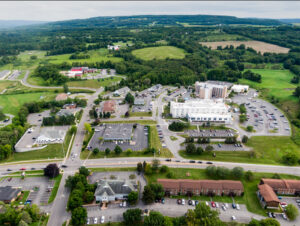By Jolene Cleaver

At Hamilton’s Community Memorial Hospital, a $31.5 million facility project that will expand and renovate patient care spaces is well underway.
The hospital opened in 1952 and the last big upgrade was in the 1980s when an ambulatory wing was added, said Community Memorial Hospital President and CEO Jeffery Coakley.
So, a transformation was due.
The project — the largest renovation of the facility to date — will revitalize the facility and equipment, improve patient care and help safeguard more than 400 jobs present at the hospital, Coakley said.
Road to completion
Barring any unforeseen challenges, Community Memorial and construction management group, Hayner Hoyt Corp., expect the completion of the project toward the end of 2025.
And that end date will be more than five years in the making.
Coakley said planning for this project began in 2019 with the hospital community asking itself, “How do we get to a higher level of care?”
When he came on board at Community Memorial in November of 2020, work on the project had just begun.
The first leg of the project — completed in December of 2021 just as the region experienced a spike in COVID-19 infections — updated the inpatient wing and the emergency department.
This work has already proven critical as the hospital has seen overall growth of the emergency department operations to the tune of 17% since the pre-pandemic days.
Current construction work at the hospital is geared toward bringing ancillary services to the foreground by renovating space and upgrading equipment in the radiology department, laboratory, rehabilitation center and the main entrance.

The details
• The new radiology department will be centralized inside the hospital and new equipment purchases include a CT scanner, MRI machine and digital mammography unit.
• The laboratory department will have an expanded waiting space for patients with updated blood draw rooms.
• The updated Center for Rehabilitation at Community Memorial — which includes physical, occupational and speech therapies — will also be expanded.
• The new main entrance will feature a larger waiting space and a cohesive exterior to the new emergency department entrance.
“We needed to replace diagnostic and ancillary services,” Coakley said, adding that additional project improvements will make for a “modern, efficient operating theater.”
Hopes
“A facility that represents the quality of care being delivered. … It all works together,” Coakley said of identifying community needs, finding workflow efficiencies in the project planning stage and seeing it transferred to construction.
The crew at Community Memorial feels that improvements will help not just tomorrow, but set the tone for healthcare missions for decades into the future.
Oneida Health expands orthopedics, stroke services
Traveling to the north end of Madison County, another small hospital is taking big steps to serve its community.
At Oneida Health, Sara Reinhardt, director of marketing and development, recently chatted about how across the state and nation there is a huge deficit in primary care medical staff and Oneida Health has been doing well in recruitment.
To combat this trend, in recent accomplishments, Oneida Health has added medical offices and quick care facilities to its community offerings.
Last October, Hamilton Orthopaedics Spine and Sports Medicine (with offices in Hamilton and New Hartford) became an official partner of Oneida Health.
This partnership provides for Hamilton Orthopaedics surgeons Rudolph Buckley and Russell LaFrance to perform most of Hamilton Orthopaedics’ hospital-based surgical procedures in the Oneida Health operating room at Oneida Health.
More recently, in February, Oneida Health became a member of the Telestroke Network at Upstate University Hospital’s Comprehensive Stroke Center in Syracuse, Reinhardt said.
The network works by allowing Upstate University Hospital to connect its stroke specialists with the medical staff at Oneida Health to aid in the assessment and care of patients at the Oneida facility who may be experiencing a stroke.
For example, when a patient arrives at the Oneida Health emergency department and is exhibiting symptoms that coincide with a stroke, staff at Oneida Health can now consult with an Upstate stroke specialist, via a video conference connection.
Through that connection, Upstate stroke specialists can view the CT brain scan, examine the patient and talk with patients, families and physicians about early intervention and facilitating care, both are crucial steps in improving outcomes for patients suffering a stroke.
“Being part of Upstate University Hospital Stroke Center’s Telestroke Network enables our patients to receive top-notch stroke care from specialized neurologists at a tertiary care facility while remaining at their local community hospital,” said Felissa Koernig, president and CEO of Oneida Health, in a statement.
Looking forward
“We continue to build out care,” Reinhardt said, of the independent nonprofit hospital. As the hospital goes into 2026, primary care will continue to be the growth focus.
And it is a constant need.
Reinhardt added that since 2023, emergency department and quick care visits numbers have been elevated, like many hospitals in the area.
Overall, the hospital sees patients coming from Herkimer and Oneida counties, all over Madison County and even from the Syracuse area.
Related Story:
Rome Health adds more robotic surgery capabilities, expands ICU

